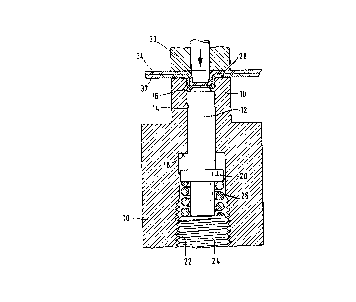Some of the information on this Web page has been provided by external sources. The Government of Canada is not responsible for the accuracy, reliability or currency of the information supplied by external sources. Users wishing to rely upon this information should consult directly with the source of the information. Content provided by external sources is not subject to official languages, privacy and accessibility requirements.
Any discrepancies in the text and image of the Claims and Abstract are due to differing posting times. Text of the Claims and Abstract are posted:
| (12) Patent: | (11) CA 2080998 |
|---|---|
| (54) English Title: | METHOD AND APPARATUS FOR THE LOCAL FORMING OF BRITTLE MATERIAL |
| (54) French Title: | METHODE ET APPAREIL DE FACONNAGE LOCALISE DE MATERIAU CASSANT |
| Status: | Expired and beyond the Period of Reversal |
| (51) International Patent Classification (IPC): |
|
|---|---|
| (72) Inventors : |
|
| (73) Owners : |
|
| (71) Applicants : |
|
| (74) Agent: | SMART & BIGGAR LP |
| (74) Associate agent: | |
| (45) Issued: | 1999-09-07 |
| (22) Filed Date: | 1992-10-20 |
| (41) Open to Public Inspection: | 1993-05-14 |
| Examination requested: | 1996-08-28 |
| Availability of licence: | N/A |
| Dedicated to the Public: | N/A |
| (25) Language of filing: | English |
| Patent Cooperation Treaty (PCT): | No |
|---|
| (30) Application Priority Data: | ||||||
|---|---|---|---|---|---|---|
|
Method for the local forming of material tending
towards brittle fracture, such as certain aluminium
alloys, in which during the forming tensile loads are
exerted on the material, such as for example in joggle
joining. brittle fracture is avoided if the material is
subjected to a pressure load in the region which is to
be formed.
Note: Claims are shown in the official language in which they were submitted.
Note: Descriptions are shown in the official language in which they were submitted.

2024-08-01:As part of the Next Generation Patents (NGP) transition, the Canadian Patents Database (CPD) now contains a more detailed Event History, which replicates the Event Log of our new back-office solution.
Please note that "Inactive:" events refers to events no longer in use in our new back-office solution.
For a clearer understanding of the status of the application/patent presented on this page, the site Disclaimer , as well as the definitions for Patent , Event History , Maintenance Fee and Payment History should be consulted.
| Description | Date |
|---|---|
| Inactive: IPC from MCD | 2006-03-11 |
| Time Limit for Reversal Expired | 2000-10-20 |
| Letter Sent | 1999-10-20 |
| Grant by Issuance | 1999-09-07 |
| Inactive: Cover page published | 1999-09-06 |
| Inactive: Final fee received | 1999-05-31 |
| Pre-grant | 1999-05-31 |
| Letter Sent | 1999-03-08 |
| Notice of Allowance is Issued | 1999-03-08 |
| Notice of Allowance is Issued | 1999-03-08 |
| Inactive: Status info is complete as of Log entry date | 1999-03-04 |
| Inactive: Application prosecuted on TS as of Log entry date | 1999-03-04 |
| Inactive: Approved for allowance (AFA) | 1999-02-03 |
| Request for Examination Requirements Determined Compliant | 1996-08-28 |
| All Requirements for Examination Determined Compliant | 1996-08-28 |
| Application Published (Open to Public Inspection) | 1993-05-14 |
There is no abandonment history.
The last payment was received on 1998-09-17
Note : If the full payment has not been received on or before the date indicated, a further fee may be required which may be one of the following
Patent fees are adjusted on the 1st of January every year. The amounts above are the current amounts if received by December 31 of the current year.
Please refer to the CIPO
Patent Fees
web page to see all current fee amounts.
| Fee Type | Anniversary Year | Due Date | Paid Date |
|---|---|---|---|
| MF (application, 5th anniv.) - small | 05 | 1997-10-20 | 1997-09-25 |
| MF (application, 6th anniv.) - small | 06 | 1998-10-20 | 1998-09-17 |
| Final fee - standard | 1999-05-31 |
Note: Records showing the ownership history in alphabetical order.
| Current Owners on Record |
|---|
| ECKOLD GMBH & CO. KG |
| Past Owners on Record |
|---|
| MATTHIAS DOBRIKOW |